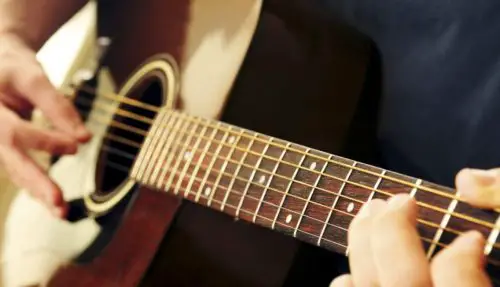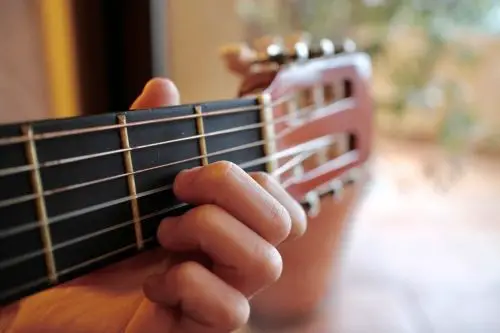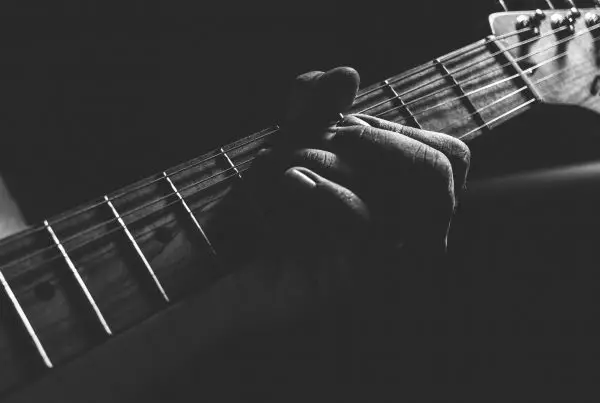How Long Does It Take to Master Chord Changes On Guitar?
It might take a couple of months or even a year to master chord changes. You can master basic chords in a matter of weeks, but for difficult chords, you might need some months to learn them properly.
Mastering chord changes on guitar completely depend on how hard you practice. Long and heavy sessions are necessary if you want to master chord changes in weeks.
It usually takes time and patience to change between chords frequently. Don’t rush too much. You have to practice regularly to properly learn the art.
After doing extensive research, I found that consistently practicing every day can help you learn to change the chords in a few 3-4 weeks, but it totally depends on how you practice. By changing the chords faster, you are able to produce good sound.
5 Tips To Get Better at Changing Chords

There are some important tips to get better at changing chords
1. Keep yourself synced with the fretboard
Always keep your fingers close to the fretboard as it makes it easier for you to change chords. Keeping your fingers near the fretboard will require the least amount of motion, which is surely essential for faster movement. One of the most common mistakes we make while playing the guitar is keeping our fingers away from the fretboard.
2. Try using pivot fingers
Keep those fingers in a central position on the fretboard to get swift movement between chords. There’s no denying the fact that some fingers don’t actually need to move when changing chords as numerous chords share the same fret.
You can use it as an anchor to make your movement flexible and fast, it is one of the most reliable techniques to get faster at changing chords.
3. Think further
One of the simplest techniques for the smooth changing of the chord is thinking ahead. Think about the chord coming up next so you can easily get prepared for it. It will allow you to change chords faster without any pauses.
4. Use a metronome
A metronome is a device known for creating an audible sound at a particular interval and it is widely used to learn guitar. When you are playing live, it is very hard to calculate time. However, to stay on time, you can use the metronome. This device helps your hand to keep the movement consistent.
5. Put all fingers at the same time
Getting faster in changing chords requires you to put all your fingers at the same time. Changing chords requires numerous coordination and you need to practice them to get smoother with time.
Also Read: 7 Easy Tips To Strum Chords On a Bass Like a Pro
3 Practice Drills For Fast Chord Changes

There are some basic tips to change chords faster
So, we are done with learning the tips to change chords faster, but what are the drills to follow? Here are the three practice drills for you;
1. Memorize chords shape
Here you need to pick the two chord shapes that you are familiar with the most. Let’s consider you chose E and A. First, you need to make the E chord shape and then A. Move between E and A consistently, but make sure you give a break of 5 seconds before shifting from one chord to another or you can just make the 1st chord and slap your lap and repeat, do this at least 10-20 times.
2. Plan out the switch
Planning your switch surely depends on the chords you start and end on. Let’s use the same example of E and A. Get used to changing your chords consistently as it will become much easier if you plan out your switch by lifting a few fingers every time you change the chord.
3. The chord-switching game
In this exercise, you can use whatever chord shape you want. Choose chord A for example and count from 1,2,3,4 and strum only on “1” and then count 2,3,4 and then move on to the next chord Do this exercise for as long as you can.
All these exercises are meant to improve you when it comes to switching between chords fast. If you are unable to understand these exercises. Here’s a video tutorial for you;
Also Read: Do You Need To Learn Barre Chords: Alternative For Beginners
FAQs
Q: How Do You Know When to Change Guitar Chords?
The best way to identify when to change chord is to tap your toe to the beat and try to count to four. Whenever you experience a shift in the melody, this is where you need to change the chords. Changing the chord certainly depends on the song you are playing. It is better to keep humming the melody of the song.
Q: Do You Keep Strumming While Changing Chords?
You have to keep strumming while changing chords if you are having difficulty shifting. People who find trouble shifting chords often keep strumming even if they are hitting open strings. Keep your right hand moving and don’t stop. You can even keep your strumming pattern slow.
Q: How Do You Strum and Change Chords at the Same Time?
The key to strum and change chords at the same time is to have a rhythm. Build the chord shape starting from the low E-string. This way, you have a small window to complete the full chord shape before you have the full downward strum.
Don’t think about where your fingers need to go, keep the strumming pattern going. This is why you need to play with a metronome, it makes it easier for you to strum and change chords at the same time.
Q Does Strumming Pattern Matter?
Strumming pattern matters a lot and is the most fundamental technique to learn if you are aiming to learn guitar. Strumming patterns helps you to create good music. The strumming pattern is known for supporting the melody or you can say the feel of the song.
Plus, it helps you maintain consistency, it becomes very hard to play guitar without consistency. It’s basically the essence of the song you are playing. Yet, there are a few strumming patterns that can work with a variety of songs. You just need to learn the right strumming patterns.





